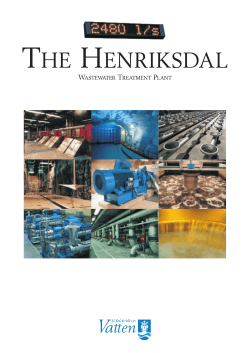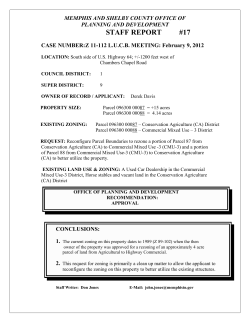
sewage treatment of Stage 1. Catchment Area Stage 2. Inlet
treatment of Stage 1. Catchment Area sewage Stage 2. Inlet Storm separation Grit removal Screening From skip to landfill Stage 3. Primary Treatment Pumping station Settlement Stage 4. Secondary Treatment Conservation and sustainability information Biological treatment Air Stage 5. Tertiary Treatment Stage 6. Sludge Treatment Biogas Additional ammonia, solids or nutrient removal Heat exchange Severn Trent Water has a strong reputation for operating our sewage treatment sites to a high standard so as to provide direct environmental protection and improve the quality of our rivers. We are also committed to enhancing biodiversity and are providing safe havens for plants and wildlife on our sewage works. Not all of the land that we occupy is used directly for sewage treatment and, by careful management, we are able to leave areas relatively undisturbed for the benefit of local populations of birds and animals. Often we work in partnership with local environmental groups and we have had many successes in maximising the potential of our sites to support conservation and biodiversity in the areas surrounding them. Centrifuge Digestion Stage 7. Energy Recovery Stage 8. Sludge Recycling Sludge cake National Grid CHP engine Transport to recycling site treatment of sewage 1. Catchment area 2. Inlet 3. Primary treatment In going about our everyday lives we use a lot of water for drinking, washing, cooking, going to the toilet and much more. By using this water it becomes polluted and the waste water we produce is known as sewage. Sewage not only comes from our homes but is also produced by offices, shops, factories and other industries. Together with rain water that runs off roofs and roads, sewage is washed, flushed, or drained into sewers. Only industrial waste that is not damaging to the sewers and the people who occasionally work in them, and that which can be treated effectively at sewage treatment works is accepted. The underground network of sewers that collects all this waste water and transports it to the sewage works is known as the sewerage system and the area it covers is the catchment area. The sewage arrives at the inlet and the sewage treatment process begins with screening. This removes debris (such as rags, sticks, plastic, cans and bricks) which could damage downstream equipment or block pipes. The sewage then passes through channels or chambers which are designed to slow the flow rate and make sure that any grit sinks to the bottom and is taken out before it damages pumps or interferes with other treatment processes. Organic matter remains in suspension and passes forward to the primary tanks. This initial settlement stage is designed to separate out heavier organic matter and any floating material. Effective operation at this point is vital to protect downstream treatment stages. Large circular or rectangular tanks continuously receive incoming screened crude sewage and are used to create relatively still conditions in which heavier materials sink to the bottom of the tank as primary sludge and fats float to the top to be removed by a scraper mechanism. Sludge is removed regularly from the base of the tanks by a system of scrapers and is then pumped away for further treatment and energy recovery where possible. The remaining light organic solids and dissolved material is carried forward in the general flow to the next stage as settled sewage. 8. Sludge recycling Because the rate at which sewage arrives at a treatment works varies - especially during heavy rainfall – excess flows are diverted at the inlet into storm tanks and returned later when capacity is available. 2. 1. Sludge has always been recycled to agricultural land. Many of the first sewage treatment works were known as sewage farms. Sludge contains nutrients such as nitrogen and phosphorous in slow release form and organic matter for conditioning the soil. Modern methods of treatment and strong environmental controls enable us to provide a safe and valuable service to farmers and those looking to restore damaged land. We usually supply digested sludge cake from treatment centres by lorry direct to the field where it is spread by agricultural equipment before being ploughed in. Screening 4. Secondary treatment Grit removal Storm Separation From skip to landfill Pumping station 3. Settlement 7. Energy recovery The biogas produced when we digest sludge contains methane which we can burn to recover energy. Usually there is more biogas than is needed for heating the digesters and, wherever possible, it is used to generate electricity. Many of our sewage works with digesters are now able to export this surplus renewable energy to the national grid. At two of our sites the sludge produced cannot be recycled to land because of contaminants from industrial discharges and we have to burn the sludge in incinerators to reduce its volume. When burnt, sludge produces heat which we use to minimise our incinerator fuel costs. 4. Air Biogas Filter beds are filled with specially selected stones or similar media which have a large surface area and provide an excellent habitat for bacteria to grow without blocking the flow of liquid and air around them. Settled sewage is broken down by the bacteria as it percolates down through the media. This robust yet simple technique imitates natural breakdown of waste and is energy efficient but requires a large land area. Activated sludge treatment is more flexible but energy intensive. Activated sludge tanks are kept continuously mixed with air either bubbled through the mixture or supplied by violent agitation at the surface. Settled sewage is continuously fed to the tanks and mixes with treatment bacteria which are continuously reclaimed from the treatment process. The process can be adapted to reduce phosphorous or nitrogen release in the final effluent. Biological treatment 6. This is a biological stage where we use bacteria and other micro-organisms to break down most of the remaining organic matter in the settled sewage into water, carbon dioxide and nitrogen. We provide the bacteria with ideal conditions in which to ‘work’ and they grow using the organic matter as their ‘food’. Surplus bacteria are regularly removed. Additional ammonia, 5.solids or nutrient removal Both types of treatment depend on settlement tanks immediately after the biological stage to separate out the bacteria that have grown and thus leave water suitable for direct discharge to the river or tertiary treatment. Centrifuge 6. Sludge treatment Treating sewage always produces sludge. Sludge contains organic material and valuable nutrients suitable for improving soil structure but requires further treatment before it is safe to use on land. We do this by ‘digesting’ the sludge in enclosed tanks. Our digestion processes use bacteria to break down the sludge and destroy any potentially dangerous pathogens. To work effectively the bacteria/sludge mix needs to be kept at the right temperature and in an atmosphere without oxygen. The process produces biogas, water and treated sludge. When digestion is complete we reduce the volume of the sludge by centrifuging out a lot of the water to produce a ‘cake’ for recycling to farm land and restoration sites. Digestion 5. Tertiary treatment 7. Heat exchange 8. Sludge cake National Grid CHP engine Severn Trent Water has a strong reputation for operating our sewage treatment sites to a high standard so as to provide direct environmental protection and improve the quality of our rivers. We are also committed to enhancing biodiversity and are providing safe havens for plants and wildlife on our sewage works. Transport to recycling site The standard of final effluent we discharge to a watercourse is determined by the Environment Agency. Where there is a need for a very high quality discharge we will install additional organic matter and/or nutrient removal technology. In Severn Trent Water the most common forms of tertiary treatment for large works are sand filters and reed beds for smaller works. Nutrient removal can be achieved by chemical or biological processes and is becoming more frequent where treatment works are being asked to meet the demands of growing local populations. Not all of the land that we occupy is used directly for sewage treatment and, by careful management, we are able to leave areas relatively undisturbed for the benefit of local populations of birds and animals. Often we work in partnership with local environmental groups and we have had many successes in maximising the potential of our sites to support conservation and biodiversity in the areas surrounding them.
© Copyright 2024





















